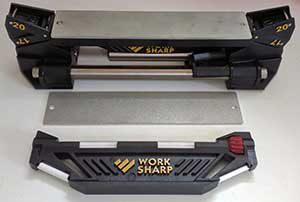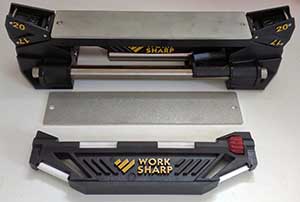Work Sharp knife sharpeners make it easier for anyone to get a razor sharp edge on their favorite blade. With all the knife reviews we’ve done, it only made sense that we’d reach out to them. For this review, we’re going to cover the Guided Sharpening System, and the companion Guided Field Sharpener. The former is more for home use, while the latter will serve you well in the field.
The system:
After 30 or so years of using a plain old two-sided stone, I figured it was time to try something new. The Guided Sharpening System is similar to a stone, but with some clever touches. It comes with a coarse 320 grit diamond plate and a fine 600 grit diamond plate. There’s also a ceramic rod. Finally, reversible guides offer 17 or 20 degree angles. All three fit on a base with rubber feet, so it doesn’t slide on your table or bench. And the base itself has a trick up its sleeve too.
Sharpening with a stone or the Guided Sharpening System is easy enough until you have to sharpen a curved blade. The smart folks at Work Sharp realized this and came up with a simple solution. On the base of the system is a sliding lock. When locked, it works like a traditional stone. Unlocked, the plate can pivot, allowing you to easily sharpen a curved blade. While this took me a bit to get used to, it’s easy to master.

Using them:
Using the Guided Sharpening System is pretty easy. After choosing the appropriate guide, snap the coarse plate into place. A few passes should create a small burr along the edge of your blade. Flip your blade over, and make the same amount of passes on the opposite side. Do the same with the fine grit plate, then proceed to the ceramic rod. Again, it works like a stone, but the pivot action really makes it easy to follow the curve of the blade. When done, I can shave fine curls off a piece of paper.
Working much the same way, the 6-3/4 inch Guided Field Sharpener is designed for use on the go. Angles are fixed at 20 degrees, and the plates are 220 grit (slightly more coarse), and 600 grit. Strong magnets keep the plates in place. A ceramic rod rotates for coarse, fine, plus grooves for fish hooks. There’s even a short narrow diameter ceramic rod for serrations, and a leather strop on the opposite side. All this, and light enough to throw in your pack and forget about, until you need it.

Conclusion:
Over the course of several months, I sharpened just about every knife I had. I took the sharpeners to work, and let my coworkers test them out too. Feedback was pretty consistent – everyone found it easy to get a sharp edge, even on curved blades. Once I explained the pivot to them, even a relative novice could do a good job. And that’s what it comes down to. I’m not an expert on all things knives. But I do own plenty of sharp objects. If you’re not an expert, but just want to keep your blades sharp, this is a great option. Of course, if you are an expert, you won’t be disappointed either.
Both carry a very fair MSRP – $59.95 for the Guided Sharpening System, and $34.95 for the Guided Field Sharpener. And they come with a 42 year warranty. Why 42 years? Because that’s how long Work Sharp has been in business. And they look forward to serving their customers for at least another 42 years. Check them out, along with the rest of the product line, at worksharptools.com.
A special thanks to Work Sharp for providing their sharpeners for this review. We review several knives each year, and end up loaning them out to staff, friends, and family. Now we’ve got an easy way to keep them all sharp.
